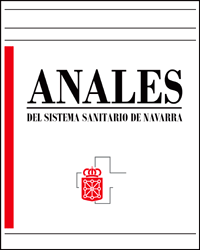Tratamiento de la pseudoartrosis recalcitrante de húmero en pacientes de edad avanzada
DOI:
https://doi.org/10.23938/ASSN.0343Palabras clave:
Húmero. Pseudoartrosis recalcitrante. Anciano.Resumen
Fundamento. La pseudoartrosis de húmero, cuando varios intentos previos para su curación ya han fracasado, es un reto. Si asociamos la osteoporosis severa propia de pacientes ancianos, las dificultades se multiplican. El objetivo es estudiar la mejor opción para esta situación.
Material y método. Analizamos la evolución de cinco pacientes con los siguientes criterios de inclusión: pseudoartrosis de la diáfisis del húmero intervenida sin éxito previamente al menos en dos ocasiones y/o haber permanecido en dicha situación más de 18 meses, asociado a osteoporosis severa en personas mayores de 65 años. Fueron tratados mediante desbridamiento del foco y estabilización con placas bloqueadas asociando injerto óseo.
Resultados. Todos los casos consolidaron tras un seguimiento medio de 19 meses (8-36 meses).
Conclusiones. En la pseudoartrosis de húmero en ancianos con hueso osteoporótico, las placas bloqueadas han demostrado que proporcionan una fijación estable y duradera, superior a la de las placas tradicionales a compresión. En nuestra experiencia hay que considerarlas también como una opción válida en situaciones de máxima precariedad ósea y biológica, como sucede en las pseudoartrosis recalcitrantes.
Descargas
Citas
1. WALKER M, PALUMBO B, BADMAN B, BROOKS J, VAN GELDEREN J, MIGHELL M. Humeral shaft fractures: a review. J Shoulder Elbow Surg 2011; 20: 1-12.
https://doi.org/10.1016/j.jse.2010.11.030
2. KONTAKIS G, TOSOUNIDIS T, PASKALOS J. Humeral diaphyseal aseptic non-unions: An algorithm of management. Injury 2007; 385: 539-549.
https://doi.org/10.1016/S0020-1383(07)80008-8
3. PARIS H, TROPIANO P, CLOUET B, CHAUDET H, POITUOUT D. Fractures diaphysaires de l'humérus: ostéosyntèse systématique par plaque. Résultats d'une série de 156 cas et revue de la littérature. Rev Chir Orthop 2000; 86: 346-359.
4. CONSTANT CR, MURLEY AHG. A clinical method of functional assessment of the shoulder. Clin Orthop 1987; 214: 160-164.
https://doi.org/10.1097/00003086-198701000-00023
5. MARTI RK, VERHEYEN CC, BESSELAAR PP. Humeral shaft nonunion: evaluation of uniform surgical repair in fifty-one patients. Orthop Trauma 2002; 16: 108-115.
https://doi.org/10.1097/00005131-200202000-00007
6. RING D, PEREY BH, JUPITER JB. The functional outcome of operative treatment of ununited fractures of the humeral diaphysis in older patients. J Bone Jt Surg 1999; 81A: 177-189.
https://doi.org/10.2106/00004623-199902000-00005
7. CANTU RV, KOVAL KJ. Las placas bloqueadas en el tratamiento de las fracturas. J Am Acad Orthop Surg (Ed Esp) 2006; 5: 137-144.
8. O'TOOLE RV, ANDERSEN RC, VESNOVSKY O, ALEXANDER M, TOPOLESKI LD, NASCONE JV et al. Are locking screws advantageous with plate fixation of humeral shaft fractures? A biomechanical analysis of synthetic and cadaveric bone. J Orthop Trauma 2008; 22: 709-715.
https://doi.org/10.1097/BOT.0b013e31818df8cb
9. GARDNER MJ, GRIFFITH MH, DEMETRAKOPOULOS D, BROPHY RH, GROSE A, HELFET DL et al. Hybrid locked plating of osteoporotic fractures of the humerus. J Bone Jt Surg 2006; 88A: 1962-1967.
https://doi.org/10.2106/00004623-200609000-00009
10. RING D, KLOEN P, KADZIELSKI J, HELFET D, JUPITER JB. Locking compression plates for osteoporotic nonunions of the diaphyseal humerus. Clin Orthop 2004; 425: 50-54.
https://doi.org/10.1097/01.blo.0000131484.27501.4b
11. GARDNER MJ, HELFET DL, LORICH DG. Has locked plating completely replaced conventional plating?. Am J Orthop 2004; 33: 439-446.
12. HAIDUKEWYCH GJ, RICCI W. Las placas bloqueadas en traumatología: actualización clínica. J Am Acad Orthop Surg (Ed Esp) 2008; 7: 371-379.
13. BORUS TD, YIAN EH, KARUNAKAR MA. A case series and review of salvage surgery for refractory humeral shaft non-union following two or more prior surgical procedures. Iowa Orthop J 2005; 25: 194-199.
14. HORNICEK FJ, ZYCH GA, HUTSON JJ, MALININ TI. Salvage of humeral nonunion with onlay bone plate allograft augmentation. Clin Orthop 2001; 386: 203-209.
https://doi.org/10.1097/00003086-200105000-00026
15. PATEL VR, MENON DK, POOL RD, SIMONIS RB. Nonunion of the humerus after failure of surgical management. J Bone Jt Surg 2000; 82B: 977-983.
https://doi.org/10.1302/0301-620X.82B7.0820977
16. MURAMATSU K, DOI K, IHARA K, MITSUNORI S, KAWAI S. Recalcitrant posttraumatic non-union of the humerus. 23 patients reconstructed with vascularized bone graft. Acta Orthop Scand 2003; 74: 95-97.
https://doi.org/10.1080/00016470310013734
17. PIÑAL F, GARCÍA-BERNAL FJ, DELGADO J, SANMARTÍN M, REGALADO J, CAGIGAL L et al. Colgajo microvascular corticoperióstico de cóndilo femoral para las pseudoartrosis diafisarias recalcitrantes de extremidad superior. Rev Ortop Traumatol 2007; 51: 62-68.
Archivos adicionales
Publicado
Cómo citar
Número
Sección
Licencia

Esta obra está bajo una licencia internacional Creative Commons Atribución-CompartirIgual 4.0.
La revista Anales del Sistema Sanitario de Navarra es publicada por el Departamento de Salud del Gobierno de Navarra (España), quien conserva los derechos patrimoniales (copyright ) sobre el artículo publicado y favorece y permite la difusión del mismo bajo licencia Creative Commons Reconocimiento-CompartirIgual 4.0 Internacional (CC BY-SA 4.0). Esta licencia permite copiar, usar, difundir, transmitir y exponer públicamente el artículo, siempre que siempre que se cite la autoría y la publicación inicial en Anales del Sistema Sanitario de Navarra, y se distinga la existencia de esta licencia de uso.








